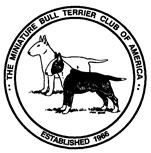|
MEDICAL
PECULIARITIES OF THE BULL TERRIER
Jerald F. Schreiber, DVM
THE HYPOCALCEMIC
BITCH
This peculiarity of the Bull
Terrier occurs in the bitch primarily around the time of whelping. It has,
to my knowledge, not been reported in the current literature available to
the veterinary profession. For this reason alone, you should find out if
your veterinarian is thoroughly familiar with our breed, because if he or
she is not, they will tend not to believe you. That is because we are
trained in Veterinary College to ignore any facts presented to us by anyone
below tile rank of full professor.
The condition manifests itself very differently from classical eclampsia in
several different ways.
1. CLASSICAL HYPOCALCEMIA (ECLAMPSIA/PUERPERAL
TETANY) - Will first be manifested by a high fever, as high as 107 F, but
more commonly around 104 F. This usually does not follow in the Bull
Terrier. The temperature in the BT will usually be slightly elevated or
normal.
2. Classical hypocalcemia most
often occurs at the time of highest calcium usage, i.e. 10- 1 2 days after
whelping (due to the large amount of milk being taken by the puppies). In
the BT, hypocalcemia usually occurs within 24 hours + or - to whelping,
although this is not a hard and fast rule.
3. Classical eclampsia usually
results in a frantic bitch who acts normally or is overprotective toward her
pups, while in the BT we usually see a frenzy and at times will attempt (and
will, if she gets the chance) to cannibalize her puppies without any regard
for her own safety. The prelude to this awful event will be familiar to the
experienced breeder. The bitch will stare at her puppies strangely as if
they were some sort of vermin (mice or rats?). Probably the low Ca level in
the blood interferes with recognition patterns, and she is in actuality
hallucinating.
Now that you can recognize this
dreaded condition, how do you prepare for it when it rears its ugly head?
Also, how can we possibly prevent it?
First my personal observation is
that bitches who are over supplemented during their pregnancy with Vitamin D
or A & D combinations (cod liver oil) and put on medium to high levels of
supplement (bone meal, di-calcium phosphate, etc.) are the ones who seem
most prone to this - so DON'T use anything extra during the pregnancy. It is
all right to supplement after the pups are born. Calcium gluconate is the
drug of choice for classical eclampsia by veterinarians' worldwide. But what
do you do if your Bully bitch is not showing classical symptoms, and he
refuses to give the treatment because he has never encountered this problem
and has no backup in writing in his references; or she doesn't have a fever;
or she is not convulsing; or is not showing the typical signs of eclampsia?
CALPHOSAN solution can be given
intramuscularly, subcutaneously or intravenously. This means that with a
modicum of training you can give the treatment yourself and not have the
hassle of fighting with someone who is ignorant of your problem while you
have an acute emergency; 5cc is the usual dose, and when given under the
skin, the bitch will return to normal in about 15-20 minutes. In severe
cases, I give 5cc Intramuscularly and 5cc Subcutaneously and repeat in one
hour. Follow-up treatment consists of using CORTISONE-USP, 25mg/tab. One
tablet, two or three times daily until the puppies are weaned. DON'T USE:
Prednisone, Prednisalone, Triamcinalone or Dexamethasone these highly
refined steroids will NOT work here. I use good old-fashioned Cortisone
precisely because it has all those bad side effects; 1) It mobilizes Calcium
from the bones to the blood, 2) It makes them hungry and 3) It makes them
thirsty.
So now you are armed with
knowledge that even your own veterinarian may not have. Use it to good
effect.
COMMENTS AND OBSERVATIONS:
If a bitch exhibits this once,
she may never show it again. On the other hand, if she has never shown it,
it is just as likely to show up unexpectedly (unannounced, of course). I do
not know what triggers it, and I do not feel that this is an inherited
problem in a simple dominant or recessive fashion |
